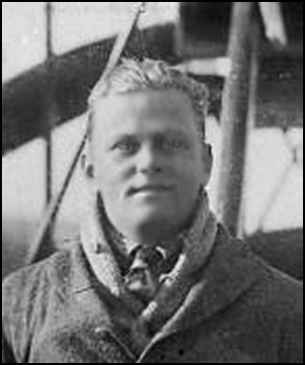
1886- AKA D. H. McCulloch |
 |
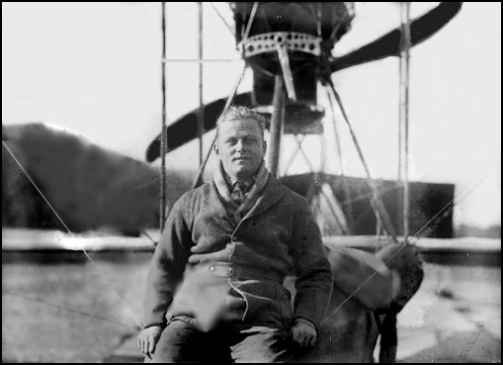 |
McCulloch was on NC-3, as Lt USN. NC-3 landed 17 May but couldn't take off because of damage and rough seas. ..and TAXIED TWO DAYS to the Azores!! Library of Congress Collection, 11-12-07 |
In January, 1915, "Signor" Callan was requested by the Italian Naval authorities to oversee the establishment of their first naval aeronautics school at Taranto. Permission was granted by the Curtiss Co., and in February, Lanny became Chief pilot instructor and assistant to the commandant of the school, to advise in all matters pertaining to the course of instruction of both officers and enlisted personnel. Callan was joined by William E. Doherty, Dave McCullough and Charles Fay, all of whom were Curtiss trained pilots Editor's Note: These paragraphs were excerpted from a copy of The Curtiss Flyleaf of 1987, a publication of the Glenn H. Curtiss Museum of Local History. I invite you to visit their site by clicking on: |
|
THE FLIGHT OF THE PRESIDENTS June 12, 2003 Reprinted by Permission "In the online magazine report "O poder da faixa" (12 of June), VEJA wrote that Washington Luis (1926-1930) was the first president to fly. From Brasilia, the minister of the Superior Military Court, Flavio Flores da Cunha Bierrenbach, wrote: "the first president of the Republic to fly was not Washington Luis, (Washington Luis Pereira de Sousa), but Wenceslau Braz (1914-1918), ten years before. On April 2, 1917, he took off from the wharf on the Ilha das Enxadas, in a hydroplane of the Naval Aviation piloted by Lieutenant Antonio Augusto Schorcht , flew over the Bay of Guanabara and continued on to Niterói . The reader Antonino Da Silva, of Mococa, São Paulo, also remembered the feat of Wenceslau Braz? the first head of State to fly in a Brazilian military airplane over the domestic territory. But it seems that VEJA, the minister and the reader had forgotten somebody. One who remembers the incident in detail is reader Graco Magalhães Alves, of Natal, Rio Grande do Norte: "Hermes da Fonseca(1910-1914) flew in a Farman military airplane piloted by Lieutenant Albert Fequant, in Mourmelon, France, in day 8 of July of 1910. On April 15, 1913, in a Curtiss airplane piloted by the American David H. McCullough, Marshal Hermes da Fonseca flew over the Bay of Guanabara, (the first flight of a Brazilian president in skies of Brazil)". (VEJA, june 26, 2002) Editor's Note: In case you read Portuguese, here is the original article from VEJA which was sent to me through the courtesy of Julio Cesar de Barros, Secretário de Redação, Revista VEJA. I am eternally grateful to him for his kindness on behalf of the magazine. O VÔO DOS PRESIDENTES Na reportagem "O poder da faixa" |
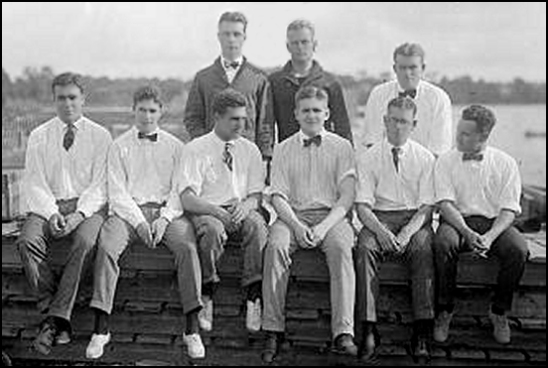 |
Robert Lovett - D.H. McCulloch - A.D. Sturtevant Vorys - Gould - Davison - Gates - Farwell - Ames Library of Congress Collection, 11-12-07 |
|
by George Henry Nettleton "A unit was organized of the following Yale men: Allan W. Ames, '18; F. Trubee Davison, '18; Henry P. Davison, Jr., '20; J. V. Farwell 3d, '18; Artemus L. Gates, '18; Erl C. B. Gould, '18; Robert A. Lovett, '18; A. D. Sturtevant, '16S.; John M. Vorys, '18; and C. D. Wisman, '14S; and in addition, Wellesby Laud Brown and Albert J. Ditman, Jr., who were not Yale men. With the help of officials of the Aero Club, Admiral Peary, and Army officers, the Unit attempted to lay down a program. This was made unusually difficutl by the fact that it had never been done before, and of course, many false steps and useless ones were taken, but while it may be a debateable question as to whether or not anti-aircraft gunnery was required for such a service, there wa no doubt that it was necessary to learn to fly seaplanes. This immediate problem was solved by ihe America Trans--Oceanic Company, an organization owned by Mr. Rodman Wanamaker, which conducted a flying school at Port Washington, Long Island, New York, under the direction of David H. McCullough, a veteran aviator at that time in the art of navigating the air and water in flying boats, one who later distinguished himself in the war as the Navy's foremost test pilot and who flew the 'NC3' in its attempt to cross the Atlantic." The book may be obtained from a number of dealers such as Amazon.com, Barnes&Noble.com, Books-A-Million.com and BookSense.com. |
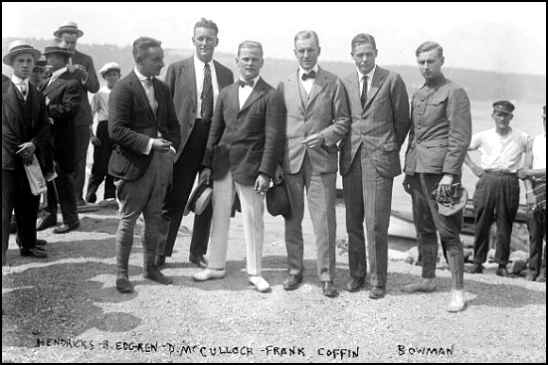 |
HENDRICKS - B. EDGREN - D. MCCULLOCH - FRANK COFFIN -------BOWMAN Frank Coffin is Frank Coffyn Library of Congress Collection, 11-12-07 |
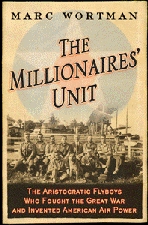 |
The Millionaires Unit Marc Wortman Product Details Paperback: 313 pages 8.8 x 5.7 x 0.9 inches Used: from $4.00 Publisher: Public Affairs, a member of the Perseus Book Group, 2006, ISBN: ISBN 13:978-1-58648-328-9 ISBN 10 1-58648-444-3 Available from Cradle of Aviation Museum in Garden City, Long Island. |
|
Description: by Bob Davis A great book of the Yale pilots. Last entry for McCullough is on page 268: "In 1919, the unit's firstinstructor, the ungovernable David McCulloch, now a career navy man, finally fufilled his war-disrupted ambition to attempt the crossing. Trans-Oceanic's big Curtiss-built America flying yachts paved the way for the NC (Navy-Curtiss) flying boats. With John Towers, the officer who got the unit into the navy in the first seat, McCulloch won the coveted assignment to co-pilot the NC-3, the lead aircraft in a three-flying boat fleet,." and "Brought down by mechanical troubles two hundred miles short of their goal, Towers, McCulloch, and crew sailed the crippled NC-3 backwards the rest of the way over the open ocean to the Azores, arriving with one wing destroyed." |
|
|


|